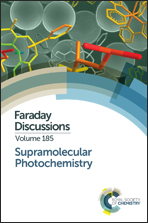Supramolecular photochemistry applied to artificial photosynthesis and molecular logic devices
Abstract
Supramolecular photochemical systems consist of photochemically active components such as chromophores, electron donors or electron acceptors that are associated via non-covalent or covalent interactions and that interact in some functional way. Examples of interactions are singlet–singlet energy transfer, triplet–triplet energy transfer, photoinduced electron transfer, quantum coherence and spin–spin magnetic interactions. Supramolecular photochemical “devices” may have applications in areas such as solar energy conversion, molecular logic, computation and data storage, biomedicine, sensing, imaging, and displays. This short review illustrates supramolecular photochemistry with examples drawn from artificial photosynthesis, molecular logic, analog photochemical devices and models for avian magnetic orientation.
- This article is part of the themed collection: Supramolecular Photochemistry

 Please wait while we load your content...
Please wait while we load your content...